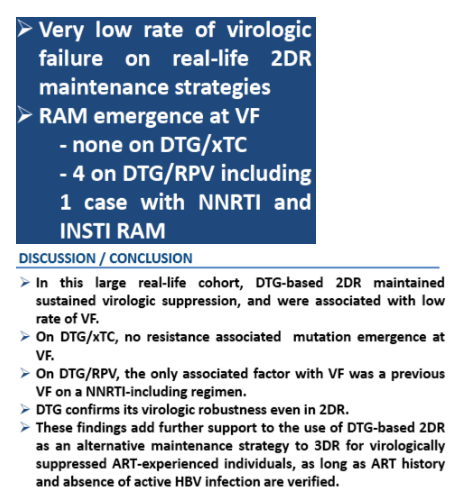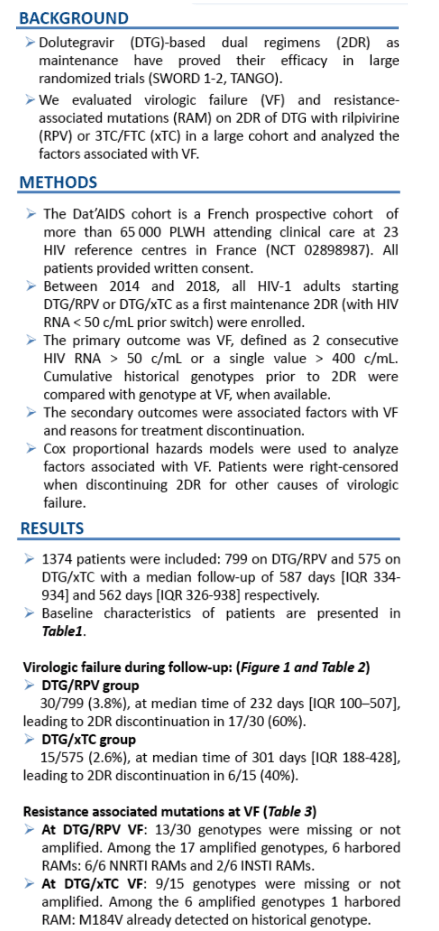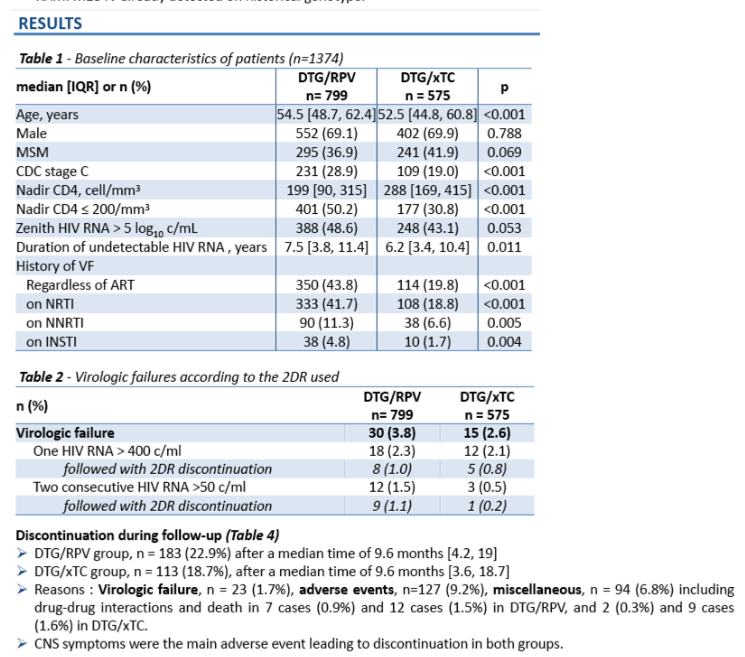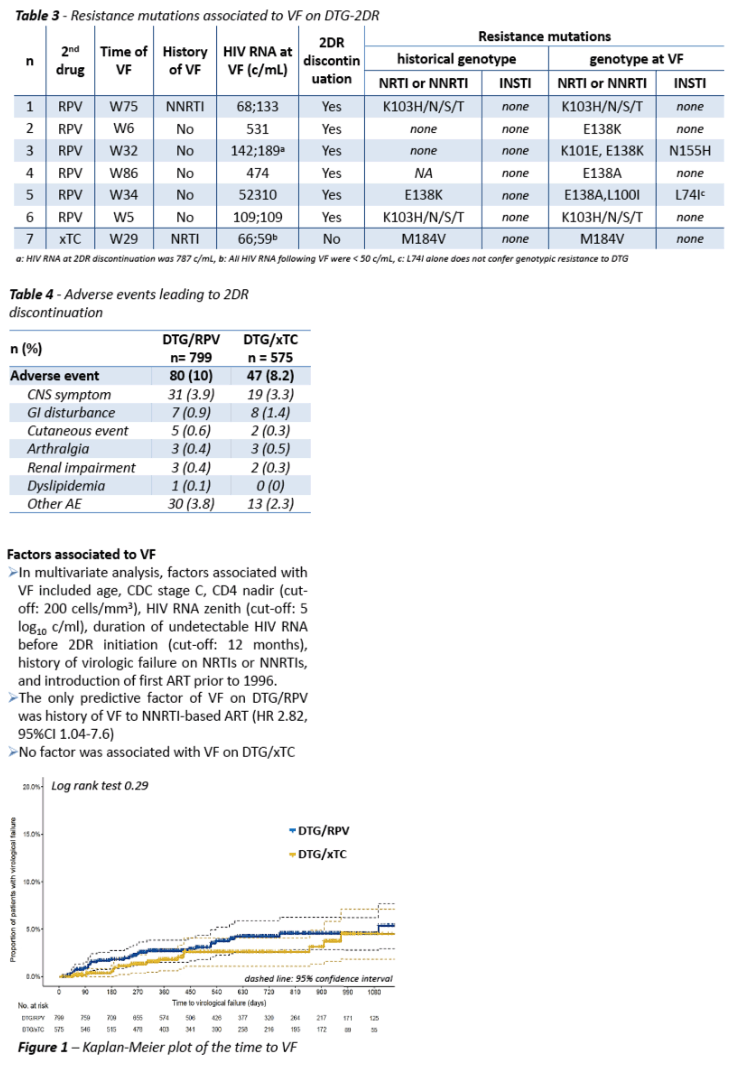 |
 |
 |
| |
VIROLOGIC FAILURE AND RESISTANCE IN
DOLUTEGRAVIR-BASED MAINTENANCE DUAL REGIMENS
|
| |
| |
CROI 2020
Reported by Jules Levin
Colin Deschanvres1, François Raffi1, Jacques Reynes2, Bruno Hoen3, David Rey4, RomainPalich5, Olivier Robineau6, FirouzeBani-Sadr7, Claudine Duvivier8, Laurent Hocqueloux9, LiseCuzin10, VeroniqueJoly11, Andre Cabie11, Clotilde Allavena1for the Dat'AIDSStudy Group
1CHU de Nantes, Nantes, France, 2CHU de Montpellier, Montpellier, France, 3CHRU de Nancy, Nancy, France, 4 HopitauxUniversitairesde Strasbourg, Strasbourg, France, 5AP-HP HopitauxUniversitairesPitie-Salpetriere, Paris, France, 5 Centre Hospitalierde Tourcoing, Tourcoing, France, 7CHU de Reims, Reims, France, 8AP-HP Necker Hospital, Paris, France, 9Centre HospitalierRegional, Orleans, France, 10CHU Fort de France, Martinique, France, 11AP-HP HopitalBichat-Claude Bernard, Paris France

Program Abstract
Maintenance ART with dolutegravir (DTG)-based dual regimens (2DR) have proved their efficacy among HIV-1 infected subjects in large and randomized trials. Real-life data are scarce with limited population and follow-up. In a large cohort (DatAIDS), we evaluated virologic failure (VF) and resistance-associated mutations (RAMs) on DTG maintenance regimens in combination with rilpivirine (RPV) or 3TC/FTC (xTC), and we analyzed the factors associated with VF.
Between 2014 and 2018, all HIV-1 adults starting DTG/RPV or DTG/xTC as a maintenance 2DR (i.e. with HIV RNA <50 c/mL) were enrolled in a retrospective analysis within the Dat'AIDS cohort (NCT02898987). VF was defined as 2 consecutive HIV RNA >50 c/mL or a single value >400 c/mL. We compared cumulative genotypes prior to 2DR and at VF (ANRS algorithm V29; 2018). Cox-models were used to analyze factors associated with VF.
1374 subjects were included (DTG/RPV: 799, DTG/xTC: 575) with a median follow-up of 587 days [IQR 334-934] and 562 days [IQR 326-938], respectively. Baseline characteristics are shown in Table. VF occurred in 3.8% (n=30) of DTG/RPV and 2.6% (n=15) of DTG/xTC subjects (p=NS), with a median delay to VF of 232 days [IQR 100-507] and 301 days [IQR 188-427], respectively. Among VF subjects, 9/30 (33%) had history of VF on NNRTI-based regimen in DTG/RPV group and 5/15 (30%) had history of VF on NRTI-based regimen in DTG/xTC group. At DTG/RPV VF, 17/30 genotypes were available: 2 genotypes harbored NNRTI RAMs already detected on historical genotypes (e138A ; e138A+L100I) ; 2 genotypes harbored new RAMs, 1 genotype with e138K on NNRTI and 1 genotype with e138K+K101e on NNRTI and N155H on INSTI. At DTG/xTC VF, 6/15 genotypes were available: no new RAM was detected and 1 genotype harbored M184V already detected on historical genotypes. The only predictive factor of VF on DTG/RPV was history of VF to NNRTI-based ART (HR 2.82, CI95% 1.04-7.6), while gender, age, duration of HIV RNA <50 c/mL prior to 2DR, nadir CD4, zenith HIV RNA and CDC stage C were not. No factor was associated with VF under DTG/xTC.
In this large real-life cohort, DTG-2DR maintained sustain HIV RNA virologic suppression, and were associated with a low rate of VF. DTX/xTC was associated with slightly lower VF rate than DTG/RPV and the absence of RAM emergence at VF. ARV history are prior VF are key issues to consider before offering 2DR maintenance.



|
| |
|
 |
 |
|
|